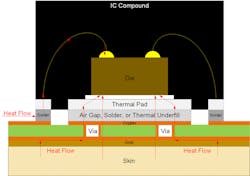Designing to Achieve Medical Temperature Measurement Accuracy
Download this article in PDF format.
Temperature is probably the most common physical measurement made during medical diagnosis or evaluation. Body temperature is an accurate predictor of many types of conditions and illnesses. The typical human temperature is within the range of 97.7°F to 99.5°F (36.5°C to 37.5°C) with 98.6°F (37°C) as being normal.
Such temperature readings are usually measured with a sensor under the tongue by a nurse with a portable thermometer. It takes less than 10 seconds. The precision is only one digit after the decimal point, but that’s generally enough to get an initial assessment for diagnostic purposes.
This approach isn’t good enough for clinical testing or for keeping track of human temperature over time. Therefore, some new method was required. Specifically, he need was for a temperature sensor with the 0.1°C precision of a resistance temperature detector (RTD) but without a 100-Ω platinum wire coil taped into your armpit.
A new approach offered by Texas Instruments gives the desired precision with a maximum error of less than ±0.3°C. This breakthrough development owes its success to a new wearable temperature sensor. TI and the University of California San Diego and San Francisco collaborated to improve wireless patient monitoring within the medical setting via TI's new digital temperature sensor, which offers ±0.1°C high accuracy.
Sponsored Resources:
- TI Sensor Innovation: Enabling Research in Wireless Patient Monitoring with the University of California
- Design Challenges of Wireless Patient Temperature Monitors
- Design with medical temperature accuracy
The Need
Demand for precise temperature measurement is critical in clinical studies and in wearable patient-monitoring products. R&D revealed that thermistors weren’t up to the task because of the difficult calibration. Though the RTD is ideal because it provides the necessary precision, it’s out of the question due to the devices’ bulk and complexity.
Semiconductor IC temperature sensors have gradually improved over the years, and with good design and packaging can meet the need. The gold standard for patient-monitoring thermometer accuracy is the American Society for Testing and Materials (ASTM) E1112. Another similar standard is ISO-80601-2-56.
Designing for Minimum Error
It was determined that for any temperature sensor to meet the required accuracy and precision, it must meet these requirements:
- The sensor must always remain in good thermal contact with the patient’s skin.
- The sensor must be thoroughly thermally isolated from all other heat sources.
- The sensor must use minimal power so that self-heating effects are negligible.
The sensor emerging from this development work is Texas Instruments’ TMP117 temperature sensor. It’s contained within a very thin small outline, no-lead, 2- × 2-mm WSON package (Fig. 1). This type of sensor measures the temperature of the silicon die. It’s designed to be used as a skin patch taped into place on the inside of wearer’s forearm.
1. This is the basic structure of the precision temperature sensor in a WSON package. Note the flexible gold base that makes good contact with the patient’s skin.
The sensor uses a thin gold base that’s flexible as well as biocompatible in order to make excellent thermal contact with the skin. Thin flexible batteries are now available to power this sensor—it will work with any voltage from 1.8 to 5.5 V. Average current draw is 3.5 µA. The recommended wireless standard is Bluetooth Low Energy, although any RF technology will work.
Summarizing the TMP117
Figure 2 shows a block diagram of the sensor. Note that the basic temperature sensor is a BJT connected as a diode. Its output is conditioned and sent to a 16-bit ADC. Least-significant-bit (LSB) resolution is 0.0078°C. The analog-to-digital converter (ADC) operates at a 1-Hz conversion cycle.
2. The TI TMP117 temperature sensor’s ADC has 16-bit resolution and the serial I/O is SMBus- or I2C-compatible.
Other features include digital offset for system correction, selectable averaging, temperature alerts, and a general purpose 48-bit EEPROM. The output is via a serial interface that’s compatible with either SMBus or I2C.
Other Applications
The TMP117 is so good it can be used in other applications. For example, it can replace PT100, PT500, and PT1000 RTDs in industrial applications. It’s also usable in environmental monitoring and thermostats. Other uses include wearables, asset tracking and cold chain, gas meters, and test and measurement equipment.
Sponsored Resources:
About the Author

Lou Frenzel
Technical Contributing Editor
Lou Frenzel is a Contributing Technology Editor for Electronic Design Magazine where he writes articles and the blog Communique and other online material on the wireless, networking, and communications sectors. Lou interviews executives and engineers, attends conferences, and researches multiple areas. Lou has been writing in some capacity for ED since 2000.
Lou has 25+ years experience in the electronics industry as an engineer and manager. He has held VP level positions with Heathkit, McGraw Hill, and has 9 years of college teaching experience. Lou holds a bachelor’s degree from the University of Houston and a master’s degree from the University of Maryland. He is author of 28 books on computer and electronic subjects and lives in Bulverde, TX with his wife Joan. His website is www.loufrenzel.com.


